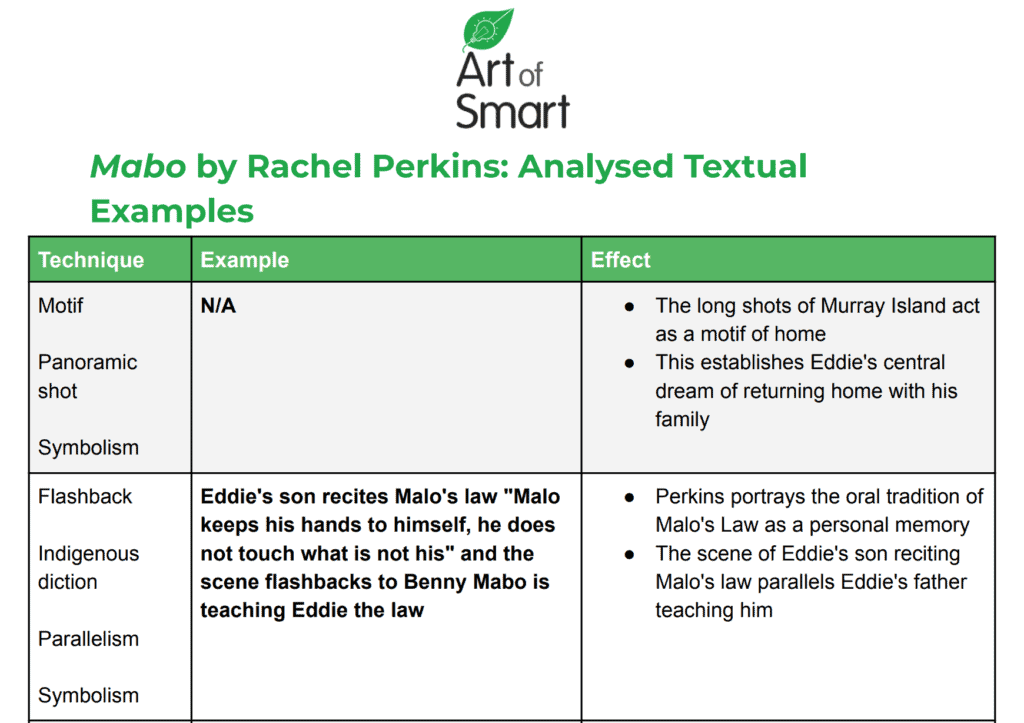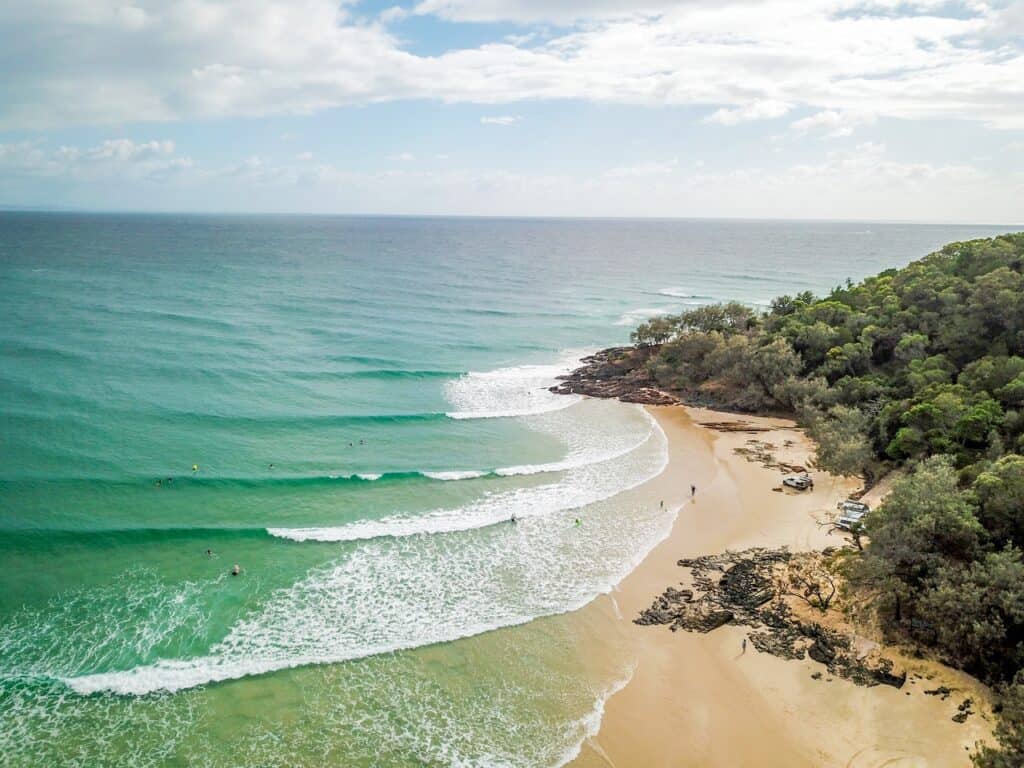Mabo (2012) is a biographical movie that follows the life of Eddie Koiki Mabo, a Torres Strait Islander person, who fought for Indigenous land rights in Australia. Check out the plot summary, key characters, and themes below to ace your Mabo film analysis for English!
We’ve also got a sample TEE table and Band 6 exemplar paragraph for you to download!
It’s time to ace your film analysis of Mabo — let’s go!
Mabo Summary
Key Characters in Mabo
Context
Themes Explored in Mabo
Film Analysis of Mabo
Plot Summary of Mabo
Mabo follows the life of Eddie Koiki Mabo, a Merriam man of the Piadaram Clan, from his exile to mainland Australia at seventeen, his love story with Bonita Mabo to the historical court battle that overturned the legal fiction of Terra Nullius.
The scene opens to Mabo’s beloved Murray Island. Eddie Mabo’s adoptive father is teaching a young Eddie Mabo traditional fishing practice and tells him “everything here is yours”. The songs and dances of the Piadaram people follow.
Presented in front of the tribal council of Indigenous elders, Eddie is tried for being seen in a “compromising position and under the influence of methylated spirits”.
The elders tell him “you’re bound by the [Meriam] law” and to see the non-Indigenous Protector, ‘Paddy’ Killoran. He is given a choice to either be Killoran’s “slave” or find work on the mainland. Eddie chooses the latter option.
Eddie works on the trochus trawlers and the outback railways. Him and his co-workers go to the pub after work. The owner refuses to serve him at the bistro and orders Eddie Mabo to go “out the back” to serve him.
Eddie sees Bonita on the street for the first time and is instantly infatuated. When he follows her to Bonita’s cousin’s wedding, he is ordered out for carrying “devil’s filth” (alcohol). The following day, Eddie’s father sends him a coconut from Murray Island as a reminder of home.
Bonita and Eddie marry and have their first child, who one day swallows kerosene. They go to the hospital and though their child is fine, they are denied a hotel room to stay overnight.
Eddie’s anger further fuels his vision of change when he sits at the bistro of the pub with a sign that says “I’m not leaving until I get a drink”.
Although Bonita tells Eddie that “we [Indigenous people] can’t afford to be troublemakers”, he joins the Aboriginal Advancement League in Cairns. He tells her, “they lobby, they fundraise and they fight to make things better.”
In 1974, Mabo is working as a gardener at James Cook University and meets historians Noel Loos and Henry Reynolds. After the Protection board denies Eddie permission to return to Murray Island to see his dying father, Henry Reynolds tells Eddie that “the land is technically not yours”.
Eddie responds: “We’ve been farming on that place since before you mob set foot on that land. We handed it down from father to son. How can we not own it?”
This sparks the beginning of Eddie’s 11-year legal quest to acquire land rights and overturn Terra Nullius. This comes at a heavy financial burden, where Mabo takes up his Meriam fishing skills and yam-growing to feed his family.
At the first trial in the Queensland Supreme Court, Mabo is humiliated as Judge Moynihan narrows his interpretation of “family” and dismisses Mabo’s land rights as an adopted son. He also judges Eddie’s character as unworthy.
Eddie, along with his friends, Sam Passi, David Passi, Celuia Mapo Salee and James Rice, take the case to the High Court in 1982, where the High Court held a 6-1 majority that Terra Nullius prevailed. In the hallway, Killoran tells Eddie “you were always one to get above yourself”.
The Queensland Parliament passes the Queensland Coast Islands Declaratory Act in 1985 to retrospectively extinguish the claimed rights of the Meriam people to the Murray Islands.
To show the custom of the Meriam people, Eddie demonstrates that the boundaries in Murray Island are known landmarks such as specific trees or mounds of rocks.
Eddie’s pain grows and he is diagnosed with cancer. He confesses to Bonita that he wishes he “spent more time at home when the kids were growing up”.
Four months after he passes, the High Court holds a 6:1 majority to overturn terra nullius and also strikes the attempt of the Queensland Coast Islands Declaratory Act to abolish native title.
Bonita tells the Murray Islanders. The film closes on Murray Island, where the phone hangs by the cord in the air and people cheer in the background.
Key Characters in Mabo
Eddie Koiki Mabo
A Meriam man, husband to Bonita Mabo and father to 10 children. For the love of his family and tradition, he fights for his land on Murray Island. He is hardworking and determined, but at the cost of his family life.
Bonita ‘Netta’ Mabo
Eddie’s wife and is a resourceful, supportive and loving woman. She is an Australian South Sea Islander of Ni-Vanuatu.
Patrick ‘Paddy’ Killoran
The ‘Protector’ of Murray Islander under the Aboriginal and Torres Strait Islander Protection Act. He opposes and tries to thwart Eddie’s legal battle.
Greg McIntyre
Lawyer who works in the Aboriginal and Torres Strait Islander Legal Service in Cairns. He represents Eddie in the final High Court case.
Bryan Keon-Cohen
Lawyer from Melbourne who works on Eddie’s case.
Ron Castan
Lawyer from Melbourne who works on Eddie’s case.
Noel Loos
Indigenous History Academic at James Cook University and friend of Eddie.
Henry Reynolds
Indigenous History Academic at James Cook University and friend of Eddie.
David Passi
Murray Islander who initially withdraws as a plaintiff of Eddie’s Supreme Court case, however returns in Eddie’s High Court case.
Context of Mabo
Rachel Perkins’ representation of Mabo as a positive hero of Australia contrasts the anti-Mabo sentiment during the time of his legal battle and the years after his victory.
The focus on Meriam customs and Eddie’s personal story offers a sympathetic, equitable side to the biography which contrasts the discrimination of past media coverage.
Linking context to the themes and arguments in your Mabo film analysis is super important, so don’t skip this step!
Anglo-Australian Legal System and Solidarity
As Eddie Mabo navigates the requirements of Australian law, his struggles reflect the cultural inflexibility of the legal system. Perkins highlights the importance of solidarity to embrace activism and bring justice for First Nations people.
Under the British Westminster legal system in 1980s Australia, the dominant white male perspective failed to recognise the social order and customary laws of the Murray people. During the beginning of Mabo, Killoran, who works as the “protector” of the Murray people, highlights the paternal attitude of the white government.
Mabo’s land rights fall through the cracks of the Queensland and High Court. Both Courts initially dismiss Eddie’s land title claims on the basis that Eddie’s demonstration of Meriam law had little merit; in other words, they upheld the false notion of terra nullius.
The Queensland government also overstepped its parliamentary power when passing the Queensland Coast Islands Declaratory Act to extinguish all Torres Strait Islander rights to land.
Racism occurs outside of the legal system too. The First Nations people are falsely considered “troublemakers” by the authorities; Eddie is randomly searched by the police, is refused service in the bistro of the pub and denied entry to visit his dying father in Murray Island.
Indigenous Family and Cultural Ties
Eddie’s dream to move back to Murray Island with his family is what drove his legal quest.
The customs of the Piadaram Clan have been passed down for over 16 generations. The songs, dances, rituals, spirituality and fishing all demonstrate the strength of Eddie’s family heritage.
Even after raising his family in mainland Australia, Eddies relies on the knowledge of his family heritage to feed his family by fishing and growing yams from the garden. However, we see that the strain of the legal battle burdens his family life — he is absent from his family and even hits Bonita in one scene.
It thus becomes shocking when the High Court does not legally recognise that the Meriam people owned Murray Island.
Themes in Mabo
Rachel Perkins’ Mabo offers intriguing themes surrounding Indigenous solidarity and justice. Consider the following themes:
1. Change vs. stagnation
While Koiki demanded change against the racist notion of terra nullius, those in power — such as the Queensland Premier Joh Bjelke-Petersen, the Queensland Supreme Court, part of the general public — sought for a stagnant social hierarchy, where settler sovereignty remained legally “true”.
Change allows us to imagine a better future for all. But for real change to occur, people must have courage to challenge what is “true” and make room for new rules.
2. Family and belonging
Perkins offers a personal story of the Mabo decision, where family and belonging is equally important as political change. Eddie’s understanding and love for Murray Island fuels his unfailing courage and vision for Indigenous Australia.
3. Identity and cultural heritage
The scene of Eddie Koiki Mabo sharing stories of his ancestry with his grandchildren under the starlit sky serves as a powerful symbol of the importance of cultural heritage.
His tales of the Torres Strait Islands’ traditions and customs not only connect the younger generation to their roots but also illustrate the resilience and richness of Indigenous culture.
The contrast between these intimate moments and the broader societal ignorance of Indigenous heritage highlights the struggle to preserve identity in the face of cultural erasure.
Perkins’ deliberate use of these personal narratives amidst the backdrop of societal indifference underscores the significance of reclaiming and honoring one’s cultural heritage in the pursuit of justice and recognition.
3. Love and solidarity
Perkins envisions Mabo as a love story. There is a love story between Eddie and Bonita, but also between Eddie’s love for his land and people.
The tenacity of Eddie’s love is tested by his legal quest. How does Eddie’s marriage falter while he struggles to navigate the legal system? How does his exile and David Passi’s initial betrayal affect him?
4. Racism and justice in Australia
Mabo is a tale of justice. Eddie’s fight against everyday racism, from the patronising Island protector Paddy Killoran, the racist pub segregation, and his lack of union rights, confronts us to what unjust rules may be occurring today.
Mabo considers how justice is not just about formal law, but about the things that happen everyday.
5. Personal sacrifice and resilience
Intimate moments between Eddie and his wife, Bonita, reveal the personal sacrifices made in the pursuit of justice. Perkins captures the strain on their relationship caused by Eddie’s unwavering commitment to the cause, showcasing the toll activism takes on familial bonds.
The juxtaposition of familial tensions with Eddie’s determination underscores the resilience required to navigate personal sacrifices while staying true to one’s principles.
The film subtly emphasizes the human cost of activism, portraying Eddie’s personal struggles and the resilience needed to persevere despite these challenges, ultimately highlighting the immense sacrifices individuals make for the greater good.
Mabo Film Analysis in 3 Steps
Often students will try to start with their thesis when trying to answer an essay question. Instead, start with your analysis! You need to equip yourself with the knowledge of your text before you can answer anything about it.
After you’ve analysed your text, you can draw ideas from it, then you can build your thesis!
We’re going to walk you through creating an analysis for ‘Mabo’ in three simple steps!
Step 1: Choose your example
The best way to choose an example is to find a technique. The technique is the key to unlocking deeper meaning in a text, which you will need in your analysis.
Mabo is a documentary and it is therefore important to incorporate visual and filmic techniques in your analysis. Want to learn more about filmic techniques? Here’s our analysis of Rear Window for you to check out!
For this example, we’ll look at the scene where Eddie’s son recites Malo’s law to Noels Loo and Henry Reynolds.
Step 2: Identify your technique(s)
When trying to find a technique within your example, it’s not about finding the fanciest technique or just any old technique for that matter!
It’s about identifying a technique which will enable you to say something about your idea that’s interesting and can contribute to your argument and analysis.
Try to focus on finding examples with techniques which unveil a deeper meaning like metaphors, similes, figurative language, connotations, symbolism and recurring motifs. Other techniques like alliteration and repetition are a bit harder to find a deeper meaning in!
We have identified 3 techniques in the quote above: flashback, juxtaposition, symbolism
Step 3: Write the analysis
When you write the analysis, it is important to always focus on what the effect of the technique is. One of the worst things you can do when writing analysis is technique labelling. Technique labelling would look like this:
The juxtaposing scenes of Eddie’s son’s recital of Malo’s Law and the flashback to Benny Mabo reciting it to young Eddie symbolise how the oral tradition is handed down from father to son.
Instead of this we need to flesh out how each of those techniques get us to our point. We should explore how Perkins communicates Malo’s Law as a personal story and how this makes the audience realise that Mabo’s family life is just as important as his legal battle:
The scenes of Eddie’s son’s recital of Malo’s law and the flashback to Benny Mabo reciting it to young Eddie effectively symbolises the oral tradition of Malo law as a personal father-son memory. Perkins juxtaposes Eddie’s family life and belonging as important as his far-reaching political and legal struggles.
Need help analysing other texts?
Check out other guides we’ve created below:
- Burial Rites
- Howl’s Moving Castle
- 1984
- Jane Eyre
- Little Miss Sunshine
- In Cold Blood
- The 7 Stages of Grieving
- Much Ado About Nothing
- Never Let Me Go
- Hag-Seed
- Blade Runner
- Fahrenheit 451
Are you looking for some extra help with your film analysis of Mabo?
We have an incredible team of tutors and mentors!
We can help you master your analysis of Mabo by taking you through the summary, context, key characters and themes. We’ll also help you ace your upcoming English assessments with personalised lessons conducted one-on-one in your home or online!
We’ve supported over 8,000 students over the last 11 years, and on average our students score mark improvements of over 20%!
To find out more and get started with an inspirational tutor and mentor, get in touch today or give us a ring on 1300 267 888!
Lynn Chen is a Content Writer at Art of Smart Education and is a Communication student at UTS with a major in Creative Writing. Lynn’s articles have been published in Vertigo, The Comma, and Shut Up and Go. In her spare time, she also writes poetry.









